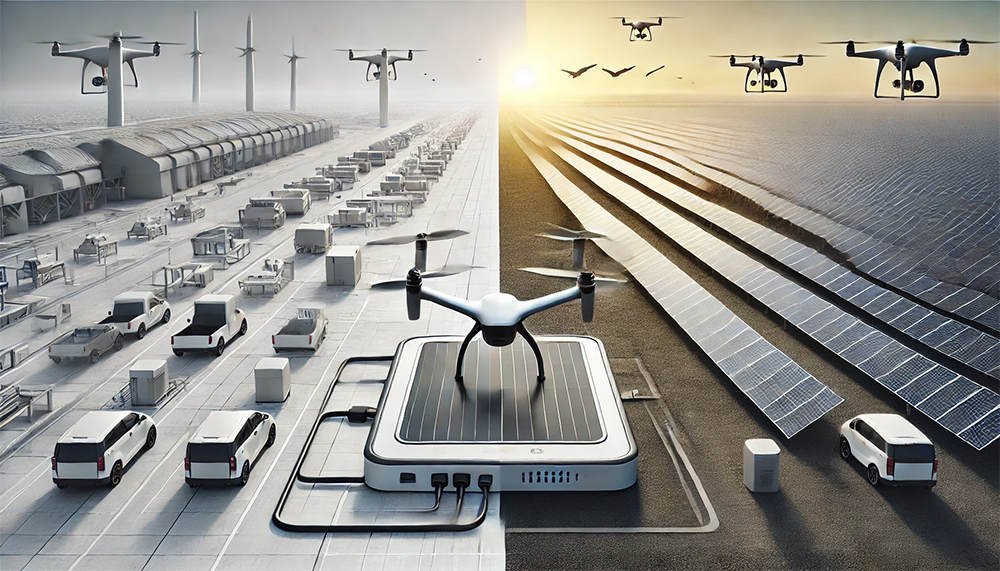Gallium Nitride Technology (65W 100W Gan charger) is expected to solve the problem of drone endurance?
With the rapid development of drone technology in recent years, the application scope of drones has been continuously expanding. From agriculture to logistics and transportation to aerial photography, drones have played an important role in all walks of life. However, battery life is still one of the main bottlenecks of drone applications. Drones consume a lot of electricity during flight, and their batteries usually need to be charged frequently. For drone users who work for a long time and travel photography, fast charging and high-power chargers have become our first choice. At the same time, drone chargers also need to be safe, portable and operable to adapt to complex and diverse working environments. At present, there are roughly the following types of drone chargers:
1. Specific drone chargers or multiple battery rotations
In addition to using the drone's exclusive charger. Before the battery life problem was completely solved, the first method that came to mind was to equip multiple batteries, so that uninterrupted battery life could be achieved by replacing batteries. Does this look very similar to mobile phones before 2010? But the problem also comes with it. When the battery is exhausted, we have to consider how to quickly charge the battery. This requires choosing a good charger that can save a lot of charging time and charge other electronic products.Learn about regular large drone chargers here.

2.Gallium nitride (GaN) technology is developing in many fields.
With the improvement of fast charging technology, drone chargers have begun to adopt more efficient power conversion technology. Gallium nitride chargers are not only smaller and lighter, but also can achieve higher power output in a smaller volume. For example, some small and medium-sized drones can support 65W or even 100W and higher output power, allowing drones to complete charging in a short time, increase battery life, and then with multiple batteries rotated, the battery life is basically solved. Now more and more drone enthusiasts prefer to use GaN chargers with power above 65w or 100w to charge their drones. Because Gan chargers can automatically adjust voltage, monitor and limit current to avoid overload and overheating, while ensuring fast charging, they can more effectively prevent potential power hazards and avoid equipment loss or burning due to overheating or short circuit problems.Click to see advantages of CaN charger
In addition to charging small and medium-sized drones, Gan chargers with multiple ports can also charge other smart home appliances and digital electronic products such as mobile phones and tablets. It can be said that Gan chargers are still very popular in the use of individual consumers (travel/shooting/home/events, etc.). Because people prefer to use one charger to charge multiple devices, rather than 10 chargers to charge 10 devices.
The following are our commonly used high-power GaN chargers

Read More

Read More
3. Wireless charger (portability/convenience)
Wireless charging technology is gradually being applied to drones. That is, the wireless charging platform can charge drones by automatic docking, but this is generally used in automated working environments (batch charging management), such as warehouse management, building inspection, etc. This type of charging technology reduces the need for manual plugging and unplugging of charging cables (reducing time cost/labor cost), improves work efficiency, and has great advantages mainly in large-scale drone management. It is rarely used by individual buyers. Reasons: high cost, technical limitations (charging speed/power and volume).

4. Solar chargers and environmental trends (future)
The increase in technology and environmental awareness has also led many companies to develop drone charging equipment that supports solar charging. Solar chargers can provide continuous power supply for drones in outdoor environments, especially in remote areas or areas without power supply. This charger not only reduces dependence on traditional power sources, but also conforms to the environmental protection concept of sustainable development. But for individuals, they need to consider the charging speed and portability.
Problems can always be solved, and new problems will arise, but this is one of the driving forces for the continuous innovation and development of science and technology.
From the above charging methods (consumers), charging efficiency, safety and portability are important factors that we need to consider when buying drone chargers. In addition to daily entertainment uses, many professional drone users, such as photographers, farmers and building inspectors, want to have portable chargers that can charge quickly. As the price of drones drops, more and more consumers (hobbyists) are also starting to use drones, which will further promote the development of new technologies for efficient drone chargers. Just like smartphones at the time, new mobile phone charging technologies are constantly being introduced.